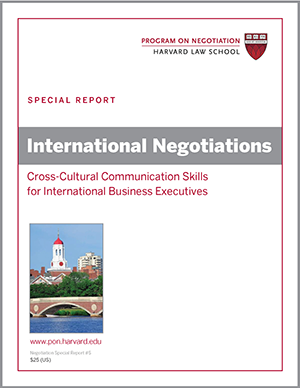
In our global economy, organizations have unprecedented opportunities to grow by forming partnerships worldwide. Yet when we are negotiating abroad, cultural, language, and other differences can lead to misunderstandings that may eventually spiral into conflicts ranging from labor strikes to lawsuits to broken partnerships that require conflict resolution. At the same time, we want to avoid stereotyping our counterparts and the way they negotiate and manage conflict based on a superficial understanding of their culture.
In a 2016 article, Priya Gupta of the Symbiosis Centre for Management and Human Resource Development in India and her colleagues took a look at the conflict-management styles of 503 workers in India, including IT professionals, employees of manufacturing companies, medical professionals, owners of start-up companies, and independent consultants. The results remind us of the importance of considering the whole person when negotiating both at home and abroad.
Approach Over Avoidance in Conflict Resolution
Past studies had reached contradictory conclusions about Indians’ approach to conflict management—for example, whether they were focused on collaborating or competing, or whether they were conflict-avoidant or more proactive. Gupta and her team hypothesized that age and gender might explain some of these inconsistencies.
The researchers sorted the employees’ responses by generation: 69% belonged to Generation Y (aka “millennials,” born after 1983, as defined by the researchers), 17% were Generation Xers (born between 1963 and 1983), and 14% were baby boomers (born between 1946 and 1964). Sixty-nine percent of those surveyed were male.
The respondents completed a 20-item questionnaire that was designed to measure which of five conflict-resolution styles they adopted on the job. Two of the styles, resignation and withdrawal, were characterized as avoidant. The other three—confrontation, compromise, and negotiation (a mixture of confrontation and compromise)—were characterized as approach-oriented styles.
Across generation and gender, the Indians surveyed preferred an approach-based strategy over avoidance, and negotiation in particular. Confrontation was the second-most-popular style. The researchers attributed this reported tendency to deal with conflict directly to India’s collectivist culture, which emphasizes group decision making, consensus, and collaboration.
Men and women didn’t differ significantly in their conflict resolution style. Some generational differences did emerge, however. Baby boomers’ preferred style was confrontation, suggesting that they bring a win-lose orientation to conflict resolution. By contrast, members of Generation Y were least drawn to confrontation, preferring a more inclusive and integrative style.
Beyond Generalities
The study results underscored the fact that individual negotiators are never simply walking, talking cultural stereotypes. In this study, age was also a factor in determining how people dealt with conflict. Moreover, Indians’ preferred conflict-resolution styles seem not much different from those of Americans and other Westerners. Many other traits, including education, experience, profession, and personality, doubtless play at least as strong a role as culture when determining how people deal with conflict.
The lesson? When meeting a new negotiating counterpart, focus on understanding her as a unique individual rather than an ambassador of her culture, generation, or gender. But you might consider drawing on research results on negotiation and culture when confronted with puzzling negotiating behavior or when attempting to quickly resolve conflict.
How do you approach conflict management?
Resource: “Boomers Like to Confront, Generation Y Is Okay with Withdrawal, But They All Love to Negotiate in India,” by Priya Gupta, Sonali Bhattacharya, Netra Neelam, and Monika Kunte. Conflict Resolution Quarterly, 2016.





